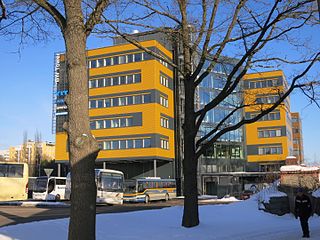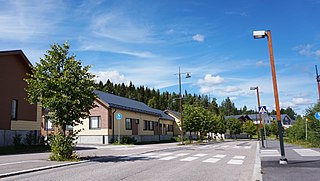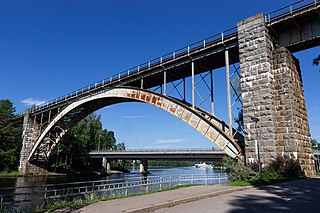
Lahti is a city in Finland and the regional capital of Päijät-Häme. It is located in the Finnish Lakeland. The population of Lahti is approximately 121,000, while the sub-region has a population of approximately 205,000. It is the 9th most populous municipality in Finland, and the sixth most populous urban area in the country.

Päijät-Häme is a region in Southern Finland south of the lake Päijänne. It borders the regions of Uusimaa, Kanta-Häme, Pirkanmaa, Central Finland, South Savo and Kymenlaakso. The biggest city in the region is Lahti.

The Lahti railway station is located in the city of Lahti in Finland.

Etelä-Suomen Sanomat is a Finnish daily newspaper published in Lahti, Finland. It is the leading paper in its metropolitan area.

BW Tower is an office building located in Lahti, Finland. The building was designed by the Finnish architecture company Arkkitehtipalvelu Oy Jyväskylä and completed in the end of the year 2015. The name of the building originates from the coat of arms of Lahti which depicts a burning wheel.

Kaarlo Könönen was a Finnish architect. He graduated from the Helsinki University of Technology in 1919. From 1922 to 1923, Könönen worked as a city architect in Kotka. To Kotkansaari he designed several apartment buildings representing 1920s classicism. The most famous one being Vuorelankulma, completed in 1927. He also worked as an architect for the Finland's Ministry of Defense in 1924. From 1925 to 1929, Könönen worked in private architectural firms, one of those was Eliel Saarinen's office in Hvitträsk.

Lahti Ski Museum is a sports museum located in Lahti, Finland, specialising in skiing and other winter sports. It is situated in the city's main sports complex adjacent to the Salpausselkä ski-jumping venue.

Ristinkirkko is the main church in Lahti, Finland. The modernist church, completed in 1978, was one of the last design projects of the renowned Finnish architect Alvar Aalto.

The Uusikylä railway station is located in the city of Lahti, Finland, in the district of Uusikylä. It is located along the Lahti–Kouvola line, and its neighboring stations are Nastola in the west and Kausala in the east.

Radio Hill is a hill located in the city centre of Lahti, Finland. It is part of the Salpausselkä ridge system, with its peak at an elevation of c. 140 metres (460 ft).

Keski-Lahti is the 1st district of the city of Lahti, in the region of Päijät-Häme, Finland. It covers the downtown areas of the city, circling the Market Square. It borders the districts of Niemi in the north, Kiveriö in the northeast, Paavola and Möysä in the east, Asemantausta in the south, Hennala and Sopenkorpi in the west and Kartano in the northwest.

Kartano is the 2nd district of the city of Lahti, in the region of Päijät-Häme, Finland. It borders the districts of Niemi in the north, Kiveriö in the east, Keski-Lahti in the south, Salpausselkä in the southwest and Jalkaranta in the west.
Ämmälä is the 21st district and a village of the city of Lahti, in the region of Päijät-Häme, Finland. It borders the districts of Kerinkallio in the north, Kujala in the northeast, Villähde in the east, Renkomäki in the west and Nikkilä in the northwest, as well as the town of Orimattila in the south. Ämmälä is largely rural in character with its thinly spread population and extensive forest and field areas. The center of the village consists of four estates - Jussila, Ristola, Ahola and Heikkilä, which surround a four-way road junction.

Renkomäki is the 22nd district of the city of Lahti, in the region of Päijät-Häme, Finland. It borders the districts of Nikkilä in the north, Ämmälä in the east and Jokimaa and Laune in the northwest, as well as the town of Orimattila in the south.

Järvenpää is the 17th district of the city of Lahti, in the region of Päijät-Häme, Finland. It borders the districts of Myllypohja in the north, Kolava in the east, Kujala in the south and Möysä in the west.

Sopenkorpi is the 26th district of the city of Lahti, in the region of Päijät-Häme, Finland. It borders the districts of Salpausselkä in the north, Kartano in the northeast, Keski-Lahti in the east, Asemantausta in the southeast, Hennala in the south and Kärpänen in the west.

Ahtiala is the 13th district of the city of Lahti, in the region of Päijät-Häme, Finland. It borders the districts of Viuha and Seesta in the north, Kunnas in the east, Koiskala in the southeast, Myllypohja in the south and Kytölä in the west.

The Vesijärvi railway station is located in the city of Lahti, Finland, in the district of Kartano. It was one end of the port and industrial siding that branched off of the Riihimäki–Saint Petersburg railway, on the west side of the Lahti railway station.

The Lahti–Loviisa railway, also called the Loviisa railway is a 1,524 mm railway in Finland, running between the Lahti railway station and the Port of Loviisa.

The Lahti–Heinola railway, also called the Heinola railway is a 1,524 mm railway in Finland, connecting the towns and stations of Lahti and Heinola in the region of Päijät-Häme.




















